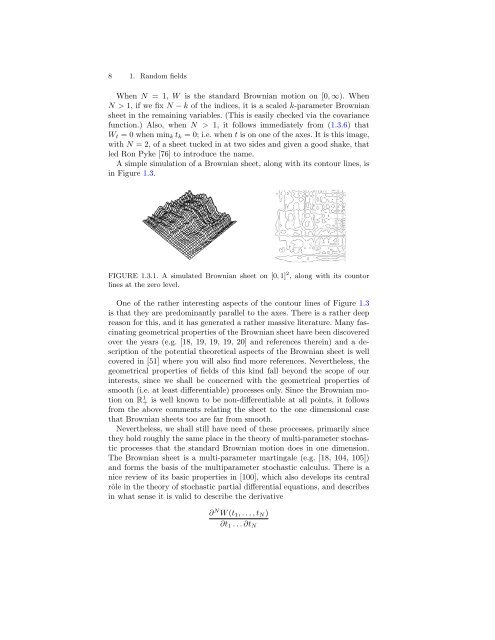Create successful ePaper yourself
Turn your PDF publications into a flip-book with our unique Google optimized e-Paper software.
8 1. Random fields<br />
When N = 1, W is the standard Brownian motion on [0, ∞). When<br />
N > 1, if we fix N − k of the indices, it is a scaled k-parameter Brownian<br />
sheet in the remaining variables. (This is easily checked via the covariance<br />
function.) Also, when N > 1, it follows immediately from (1.3.6) that<br />
Wt = 0 when mink tk = 0; i.e. when t is on one of the axes. It is this image,<br />
with N = 2, of a sheet tucked in at two sides and given a good shake, that<br />
led Ron Pyke [76] to introduce the name.<br />
A simple simulation of a Brownian sheet, along with its contour lines, is<br />
in Figure 1.3.<br />
FIGURE 1.3.1. A simulated Brownian sheet on [0, 1] 2 , along with its countor<br />
lines at the zero level.<br />
One of the rather interesting aspects of the contour lines of Figure 1.3<br />
is that they are predominantly parallel to the axes. There is a rather deep<br />
reason for this, and it has generated a rather massive literature. Many fascinating<br />
geometrical properties of the Brownian sheet have been discovered<br />
over the years (e.g. [18, 19, 19, 19, 20] and references therein) and a description<br />
of the potential theoretical aspects of the Brownian sheet is well<br />
covered in [51] where you will also find more references. Nevertheless, the<br />
geometrical properties of fields of this kind fall beyond the scope of our<br />
interests, since we shall be concerned with the geometrical properties of<br />
smooth (i.e. at least differentiable) processes only. Since the Brownian motion<br />
on R 1 + is well known to be non-differentiable at all points, it follows<br />
from the above comments relating the sheet to the one dimensional case<br />
that Brownian sheets too are far from smooth.<br />
Nevertheless, we shall still have need of these processes, primarily since<br />
they hold roughly the same place in the theory of multi-parameter stochastic<br />
processes that the standard Brownian motion does in one dimension.<br />
The Brownian sheet is a multi-parameter martingale (e.g. [18, 104, 105])<br />
and forms the basis of the multiparameter stochastic calculus. There is a<br />
nice review of its basic properties in [100], which also develops its central<br />
rôle in the theory of stochastic partial differential equations, and describes<br />
in what sense it is valid to describe the derivative<br />
∂ N W (t1, . . . , tN)<br />
∂t1 . . . ∂tN
















